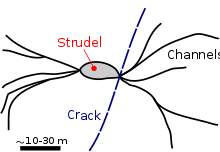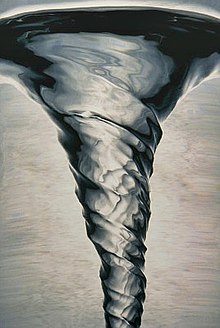


A strudel /ˈstruːdəl/ (plural: strudel)[1][2] is a vertical hole in sea ice through which downward jet-like, buoyancy-driven drainage of flood water is thought to occur.[3][4][5] This feature is less than a few tens of meters in size and typically occurs within 30 km from a river mouth, in the sea ice expanse that is fastened to the coastline (known as fast ice).[3][5] Once the water that flooded the ice has completely drained off the ice surface, strudel become recognizable by a radial pattern of feeder channels that lead to the hole.[3][5][6] They are elongated and irregularly spaced, with the larger ones up to several kilometers apart. Their distribution tends to be controlled by weak areas in the ice – in places, they line up along fractures or refrozen extensional cracks.[3] The ice sheet where they occur may be 2 m in thickness, at water depths (below the ice) in the order of a few meters.
The term strudel is German,[1] and designates a whirlpool, in reference to the water vortex that forms above these features during drainage. It has been suggested that this vortex could present a hazard for investigators wishing to study this phenomenon in the field, and that this would explain, at least partly, why little is known about strudel.[7]
- ^ a b https://en.wiktionary.orgview_html.php?sq=Envato&lang=en&q=Strudel. [dead link]
- ^ This plural form was recommended, and used, by E. Reimnitz and his colleagues.
- ^ a b c d Reimnitz, E. and Bruder, K.F., 1972. River discharge into an ice-covered ocean and related sediment dispersal, Beaufort Sea, Coast of Alaska. Geological Society of America Bulletin, 83(3): 861-866.
- ^ Walker, H.J., 1973. Salinity changes in the Colville River delta, Alaska, during breakup, International Symposia on the Role of Snow and Ice in Hydrology, Symposium on Properties and Processes, Banff, Canada, pp. 514-527.
- ^ a b c Reimnitz, E., Rodeick, C.A. and Wolf, S.C., 1974. Strudel scour: A unique marine geological phenomenon. Journal of Sedimentary Petrology, 44(2): 409-420.
- ^ Reimnitz, E., 2002. Interactions of river discharge with sea ice in proximity of Arctic Deltas: A Review. Polarforschung, 70: 123-134.
- ^ Palmer, A. & Croasdale, K. (2012). Arctic Offshore Engineering. World Scientific Publishing Company. ISBN 978-90-5699-296-5., Section 7.3.